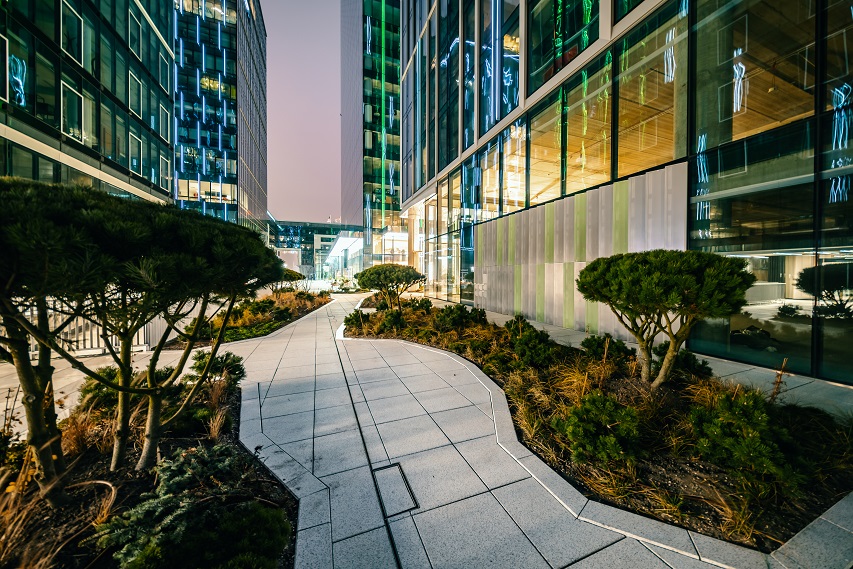Prime B, the newest building in Olivia Business Centre, has been enriched with a pocket garden, created by Maura Zaworska and Łukasz Plata, award-winning Polish landscape architects.
Greenery in urban space has been a hot topic lately. Investors most often treat greenery as a barrier in the investment implementation processes, engaging in many months of disputes with officials and conservators about the possibility of cutting down the tree stand. Meanwhile, it is difficult for experts on the subject to overestimate the role of green areas in maintaining and developing human well-being. This essence is perfectly understood by Olivia Business Centre, which has just completed work on the creation of another green area in its public spaces. This time it’s a new pocket garden.
The concept of a pocket park assumes the creation of small green areas between built-up plots, constituting an enclave of greenery in more or less compact urban development, even among the most urbanized areas of the city. In short, it can be described as introducing greenery into even the most densely built-up areas. The term originated in the United States. One of the first pocket parks is Paley Park, founded in New York City in 1967. In Poland, the trend of creating pocket parks became popular only in the second decade of the 21st century. As a curiosity, it can be added that pocket parks were established in Gdynia just after World War II, but at that time this name was not used yet.
Reading and creating the relationship between nature and the city is a design process that is constantly changing. – says Maura Zaworska, the author of the pocket garden project at Olivia Business Centre. This relationship is an inspiration for me when creating new spaces filled with greenery. For centuries, man has treated his natural part of being as something external that needs to be mastered and disciplined. The change in thinking about oneself and perceiving oneself as a being who is part of nature and whose nature is to create culture has recently led to a reconceptualization of the relationship between nature and the city, and consequently to the emergence of a design trend based on the “recreation of landscapes”. Treating nature and the investor’s requirements as complementary and interconnected elements in a non-accidental way determined the idea of the project similar to the idea of pocket parks.

The new pocket garden is filled with a total of 50 species of plants and covers the area between Olivia Star and the Prime B building. When creating this space, Maura Zaworska set herself the goal of stimulating all human senses.
A sensual garden activates the sense of sight through the introduced colors, touch, thanks to vegetation with different textures of leaves (needles), smell, if plants are designed, which give off an intense aroma (hyacinths and herbs), hearing, thanks to the grass rustling in the wind, and birds that may come, as well as taste, because as a curiosity I will add that the serviceberry that grows in the OBC has edible, exceptionally tasty fruits. I have used all of these treatments in the OBC gardens, hoping to meet the needs of employees and visitors. – emphasizes Maura Zaworska.
What’s more, the greenery has also been designed in such a way that it shapes the surroundings in various ways at different times of the year.
The plant composition assumes the introduction of white, pink and black colors in spring, blue, lavender and white in summer, yellow, orange in autumn and red in winter. The whole is composed in such a way as to maintain continuity and decorative effect in the aspects of subsequent seasons. It can be said that successive colors light up and go in the annual cycle, symbolizing the continuity and changeability of phenomena occurring over time. adds Maura Zaworska.
Therefore, the authors of the project also took into account the psychology of landscape architecture in an important way, so that the effect of their implementation would bring additional benefits not only to the end users, but also to the residents of the office center.
There are places that their users can point out as the most liked – says Maura Zaworska. They know about them and identify with them. These places have different character – sometimes so strong that it influences the formation of people’s relationships with them and individual plants. Thanks to this, they feel that they belong to this place, and they form a kind of community with the vegetation. Over time, this place becomes a tame space and gives them a sense of identity and continuity. A kind of genius loci is created, i.e. a place in relation to which a special type of bond is felt, conditioned by the strength of people’s relations with natural space. Following this path, it turns out that investing in green areas not only increases comfort and work culture, but directly translates into professional achievements and a sense of belonging to a place where the employee feels good.
There are as many as 24,400m2 of green areas at the disposal of the Residents of Olivia Business Centre on its premises or in the immediate vicinity. They are complemented by green terraces on the roofs of Prime A and B buildings, on the second floor of Olivia Star and on the connector between Olivia Point and Olivia Tower, at the height of 7 storeys. The Olivia Garden winter garden filled with exotic plants is also in preparation. Its official opening is planned for spring 2021. On the other hand, a short walk provides access to the shore of the Bay of Gdańsk or the rich forests of the Tri-City Landscape Park.




